Dan Binder grew up in a home with a cache that most kids would envy.
“Our old nine-room house was pretty much packed to the rafters with guns, uniforms, books, helmets, medals, flags, patches, coins, Indian artifacts and many other items,” he recalls.
His father, a voracious collector, was behind the houseful of artifacts. “Almost every weekend, he’d come home with more treasures from flea sales, gun and military shows, garage sales, auctions and antiques shops.”
Binder inherited his father’s collector’s gene. His collection started with seashells, followed by fossils and monster magazines. Then, a family trip to Gettysburg in the summer of 1969 forever changed then 10-year-old Dan. “Civil War materials replaced everything else collecting-wise and the urge to acquire more hasn’t left me yet.”
His early years as a collector coincided with the emergence of the Civil War artifacts market. “During the 70s, Civil War memorabilia was plentiful and what we’d now consider exceptionally inexpensive,” Binder remembers. “The problem was I was poor. Even so, I mowed lawns, shoveled snow, babysat, and raised mice and hamsters for a local pet shop to earn money that I gladly converted to things for my collection. My father helped out as often as he could. I also bought dug materials from the small typed paper lists put out by early dealers like Dave Mark and Stan Phillips.”
Binder sold his collection in 1981 to pay for college. Soon after he graduated, he returned to the hobby with what he describes as a “vengeance.” His specialty became non-dug, pre-1865 Union and Confederate military buttons.
In 2010, he branched out to photos. Binder had always liked images, but concern about prices kept him away. Today, he has more than 400 examples.
“My favorites are crystal clear, razor sharp ambrotypes of neatly groomed, healthy, and well fed young men who were just itching for war and were certain of a quick, glorious victory,” he observes. “If indeed there’s an image that’s a favorite, it’s probably the one I haven’t bought yet.”
And, his secret to collecting?
“Collect what you love and love what you collect.”
The examples published here represent a lifetime of passion.
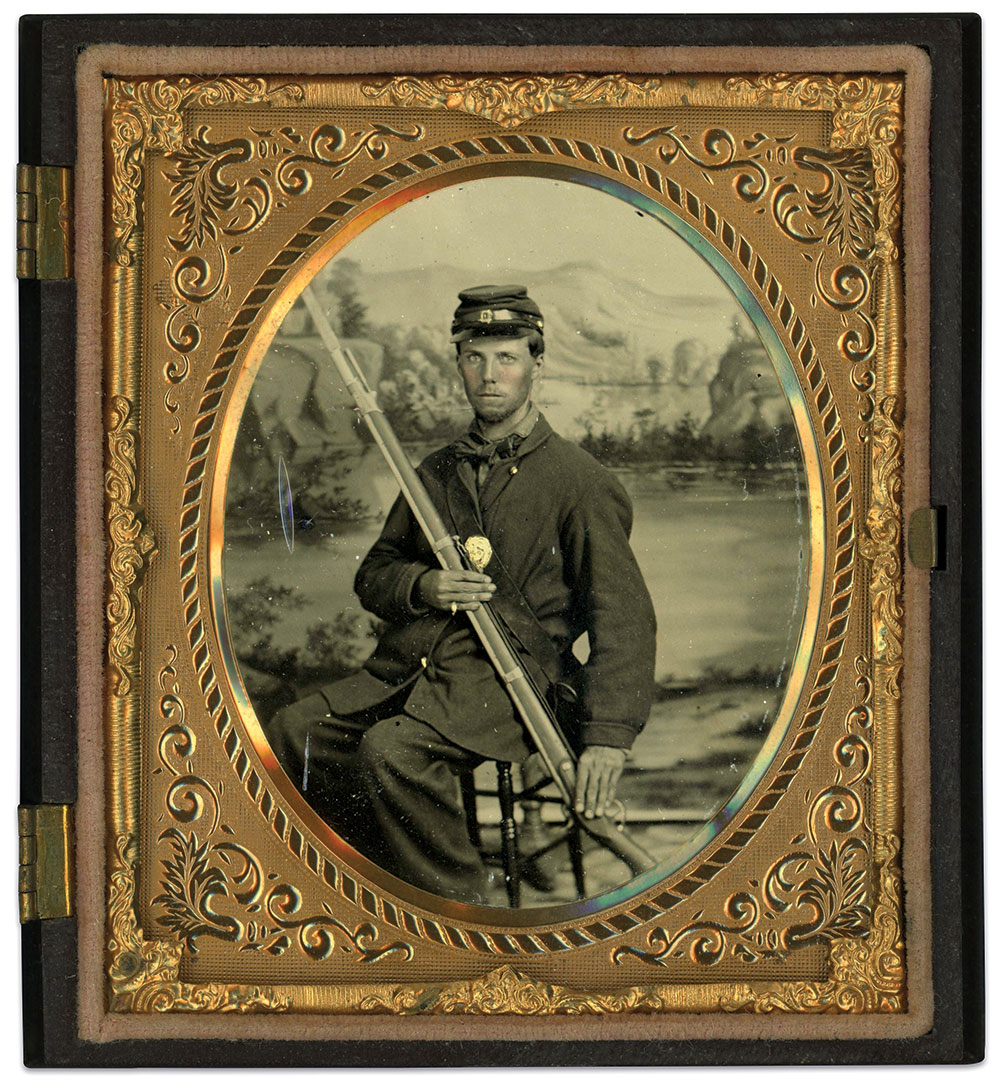
Sixth-plate ambrotype by an anonymous photographer.
The Model 1809 Pottsdam musket, a Prussian import, sits front and center in this portrait. The Union enlisted man holding it is dressed in a four-button sack coat and cap. His trousers appear dark, rather than the standard light blue for infantry troops. A regulation Pattern 1826 plate is affixed to his buff leather cartridge belt. The bucolic painted canvas backdrop that frames this soldier suggests peace rather than war.
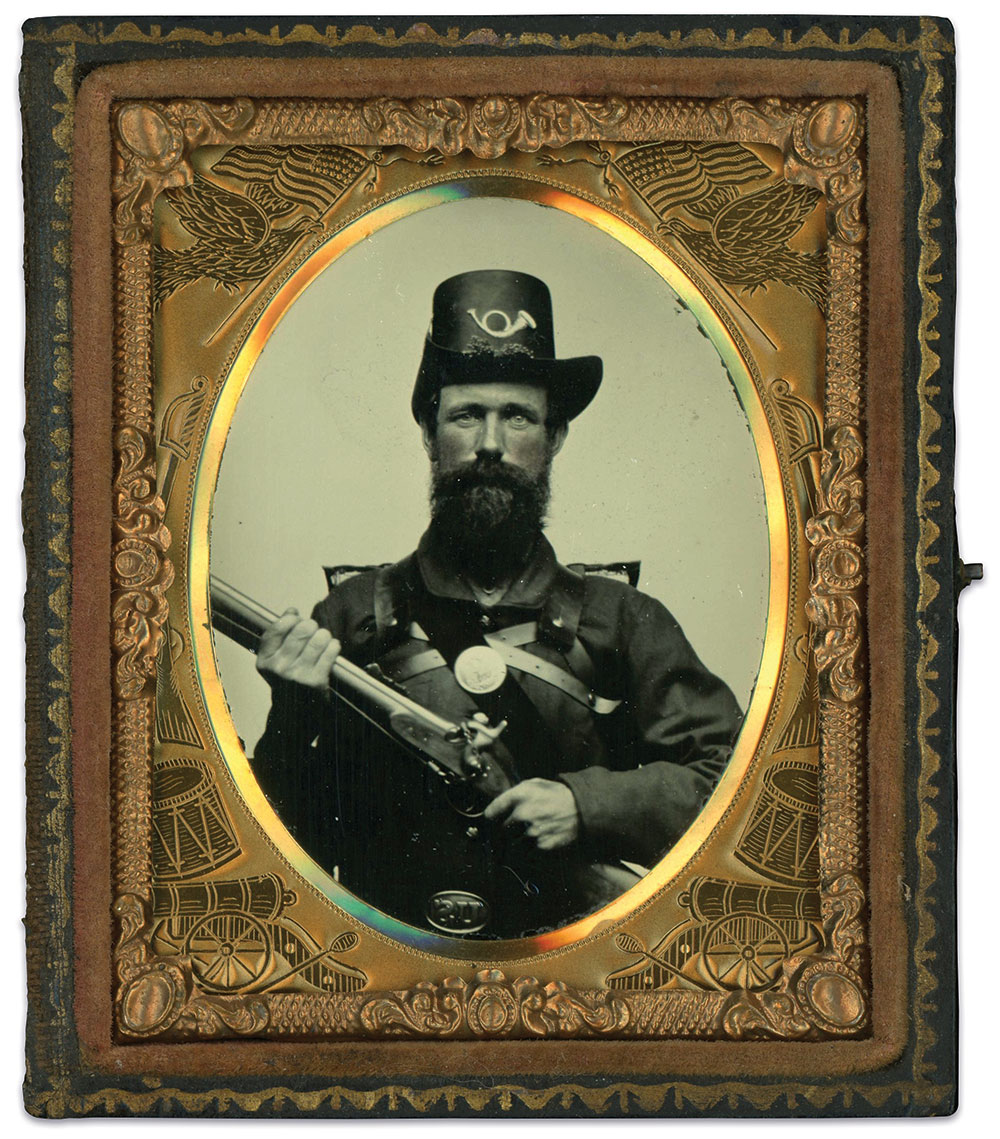
Ninth-plate ambrotype by an anonymous photographer.
The town of Winthrop, Maine, sent 193 of its military-aged men to fight the Civil War. One of them is here. Stephen H. Day, 21, enlisted in Company D of the 9th Maine Infantry in September 1861. He posed for this portrait fully prepped for camp and campaign. Armed with a Pattern 1853 Enfield rifle-musket with brass chain for the cone protector, he wears a knapsack with rolled gum blanket. Also visible is his Hardee hat, four-button sack coat, buff leather shoulder belt with Pattern 1826 plate and a waist belt with a Pattern 1839 oval US plate. Both plates were still regulation in 1861, and issued throughout the war.
Ten of Winthrop’s sons would not survive the war. Day numbered among them. He received a mortal wound at Morris Island, S.C., on Sept. 20, 1863—less than two weeks after Confederates abandoned the island’s Fort Wagner garrison, following months of fighting.
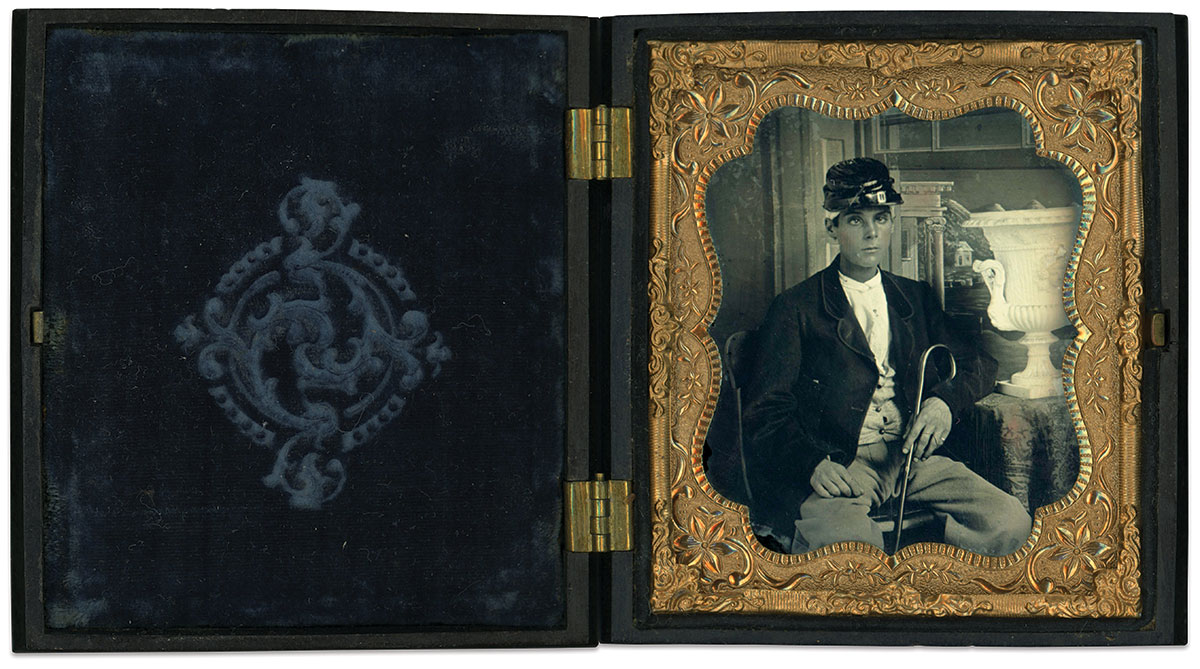
Sixth-plate ambrotype by an anonymous photographer.
This clean-shaven boy with eyes askew and a prominent bandage or dressing protected by a cap with shiny rain cover begs a question: What injury did he suffer, and how? His emaciated, haggard appearance, holding a cane and dressed in civilian clothing, suggests he is a patient at a military hospital or has been discharged from the army and is recuperating with family.

Ninth-plate ambrotype by an anonymous photographer.
Though the red-trimmed uniform worn by this militiaman is distinctive, his loyalties are unclear. The patriotic ribbon prominently affixed to his coat resembles a secession badge, and suggests Southern origins. But the object at the center of the badge is not consistent with similar examples. Therefore, the side he fought to preserve remains a mystery.
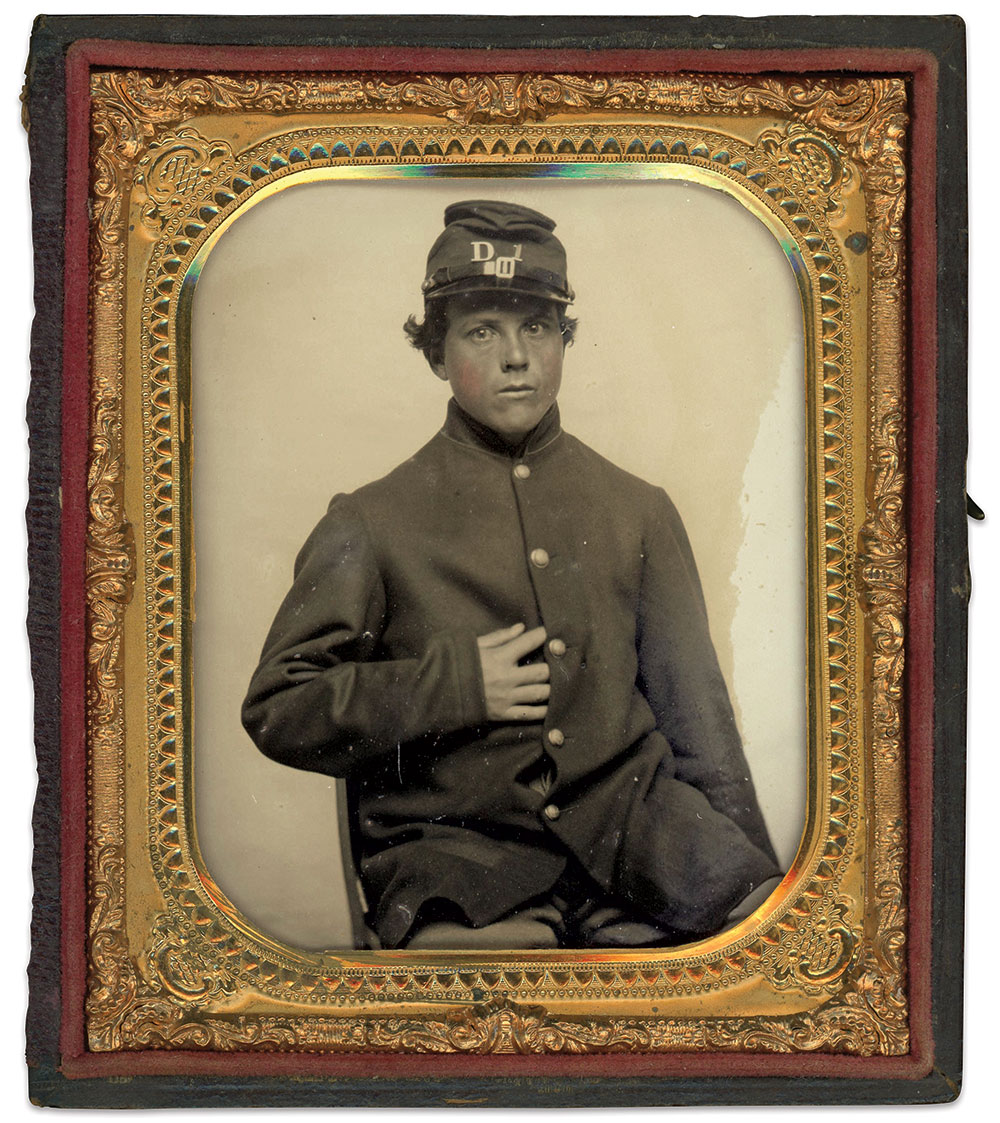
Sixth-plate ambrotype by an anonymous photographer.
The cap worn by this youthful-looking private indicates his membership in Company D of the 1st regiment. The style of his jacket and the state seal on its buttons reveal he is a Wisconsin soldier. The photographer or the sitter flipped the glass plate, or turned the emulsion side down inside the case, to compensate for the reversal effect in ambrotypes.
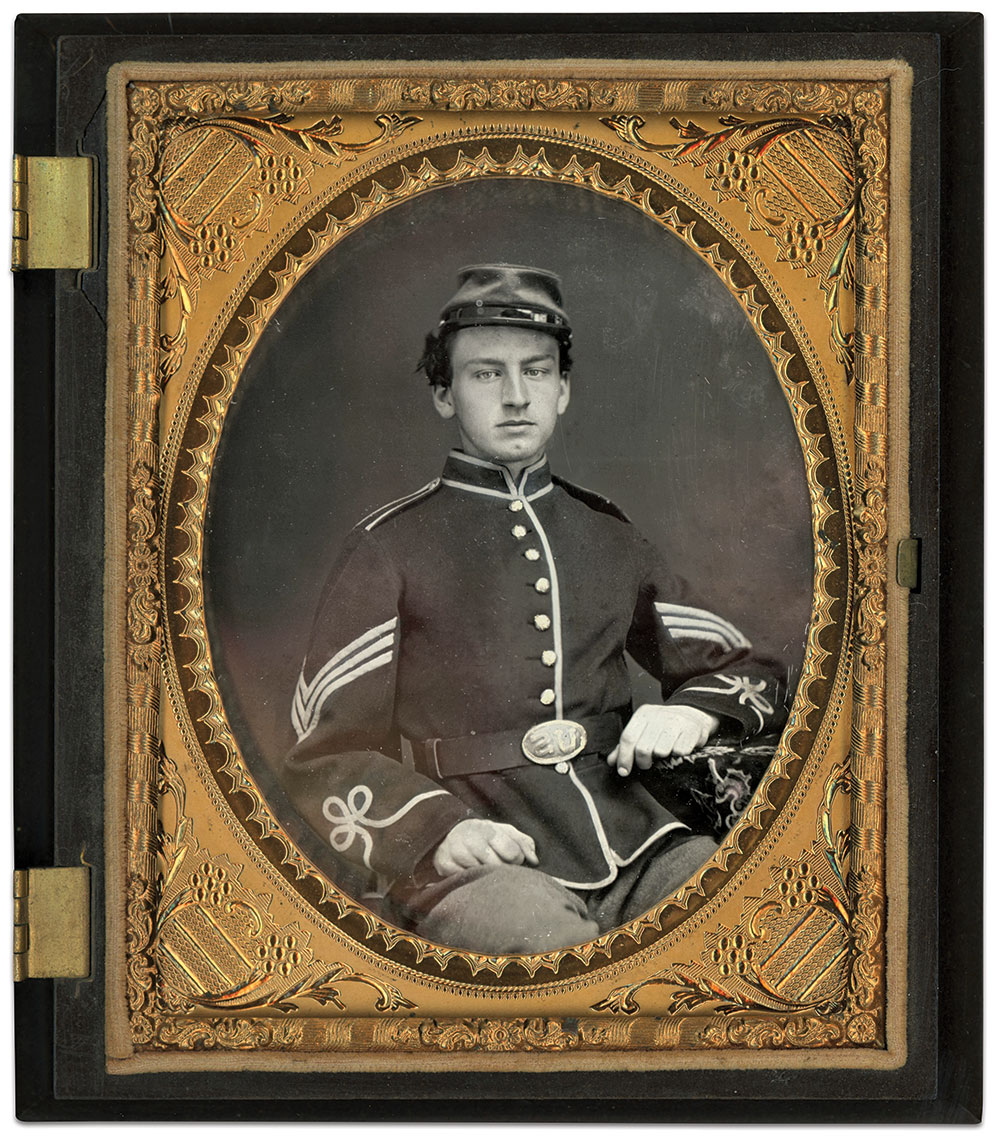
Though the daguerreotype had all but faded from the American scene by 1861, this sergeant sat for his likeness in the format. His name is lost to history. But the distinctive uniform he wears marks him as a member of the 65th New York Infantry, also known as the 1st U.S. Chasseurs. Formed in the summer of 1861, the natty regiment made quite an impression with its trefoil-trimmed cuffs, blue frock coats modified with a short skirt, and gray trousers and caps.
One news report that described a march by the regiment down Broadway enthused, “The uniform of the men, being nearly the same as that of the French Chasseurs, looked quite picturesque, and their good marching added greatly to their personal appearance on this occasion.” The original French troops, organized as light infantry, performed scouting, skirmishing and other duties that took advantage of their rapid marching capabilities. In America, Chasseur-styled regiments were treated as standard infantry. The 65th served in the Army of the Potomac, and experienced tragedies and triumphs from the Peninsula Campaign to the final assault on Petersburg.
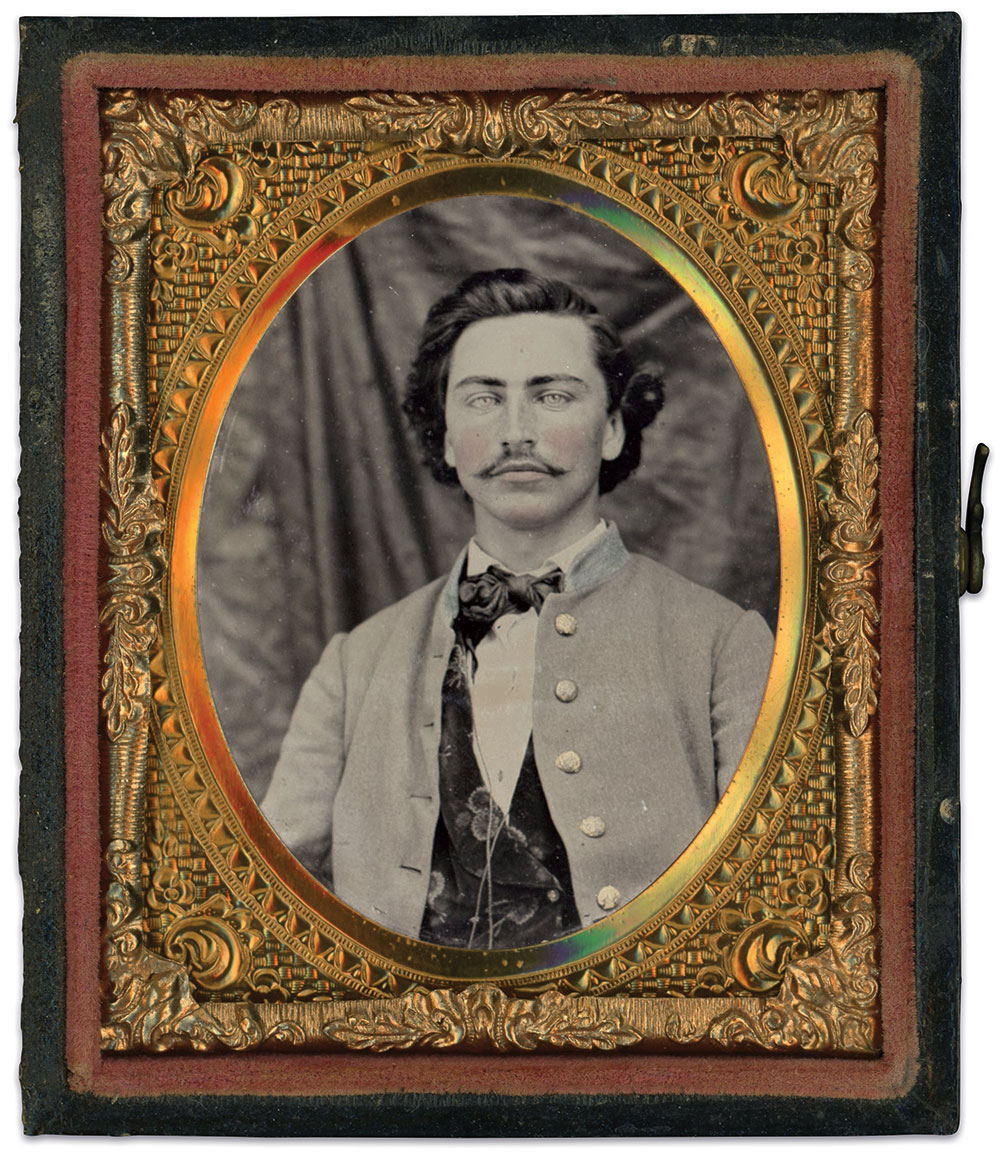
Ninth-plate tintype by an anonymous photographer.
Sporting a well-groomed mustache, this Confederate poses with his single-breasted coat, open to reveal a flowery vest and silk tie. His bearing suggests an aristocrat and officer, though no insignia are present to indicate that he holds higher rank.

Stubble around the edges of the chin beard of this soldier, and the weave of the sweater he wears are some of the details plainly visible in this portrait. Close observation of his pupils reveals a square shape, likely the reflection of the photographer’s camera.

Ninth-plate tintype by an anonymous photographer.
The deep creases in the flap of the cap pouch worn by this Union infantryman suggest hard use. Whether this occurred on the parade ground or field of battle is not known. The caps contained in the pouch most certainly ignited the fire of the U.S. Model 1816/1822 musket in his lap. Originally a flintlock, it was converted to percussion prior to the war.

Sixth-plate ambrotype by an anonymous photographer.
In an attempt to compensate for the mirroring effect of wartime ambrotypes, this trooper turned his Ohio Volunteer Militia waist belt plate upside down. The buckle happens to be the rarely seen flat letter variety issued during the earliest period of the war. His tall cap and jacket reinforce the timeframe. The jacket, with its unique trim, was issued to the 1st Ohio Cavalry. The regiment organized in the summer of 1861.

Sixth-plate tintype by an anonymous photographer.
The .32 caliber revolver and Sheffield knife tucked into the waist belt of this infantry corporal repeatedly appeared in Union soldier portraits during the early part of the war. He wears a full dress uniform, from his Hardee hat with the company letter H to his shoulder scales and white gloves. The revolver is either a Smith & Wesson No. 2 or a Prescott—nearly identical weapons.
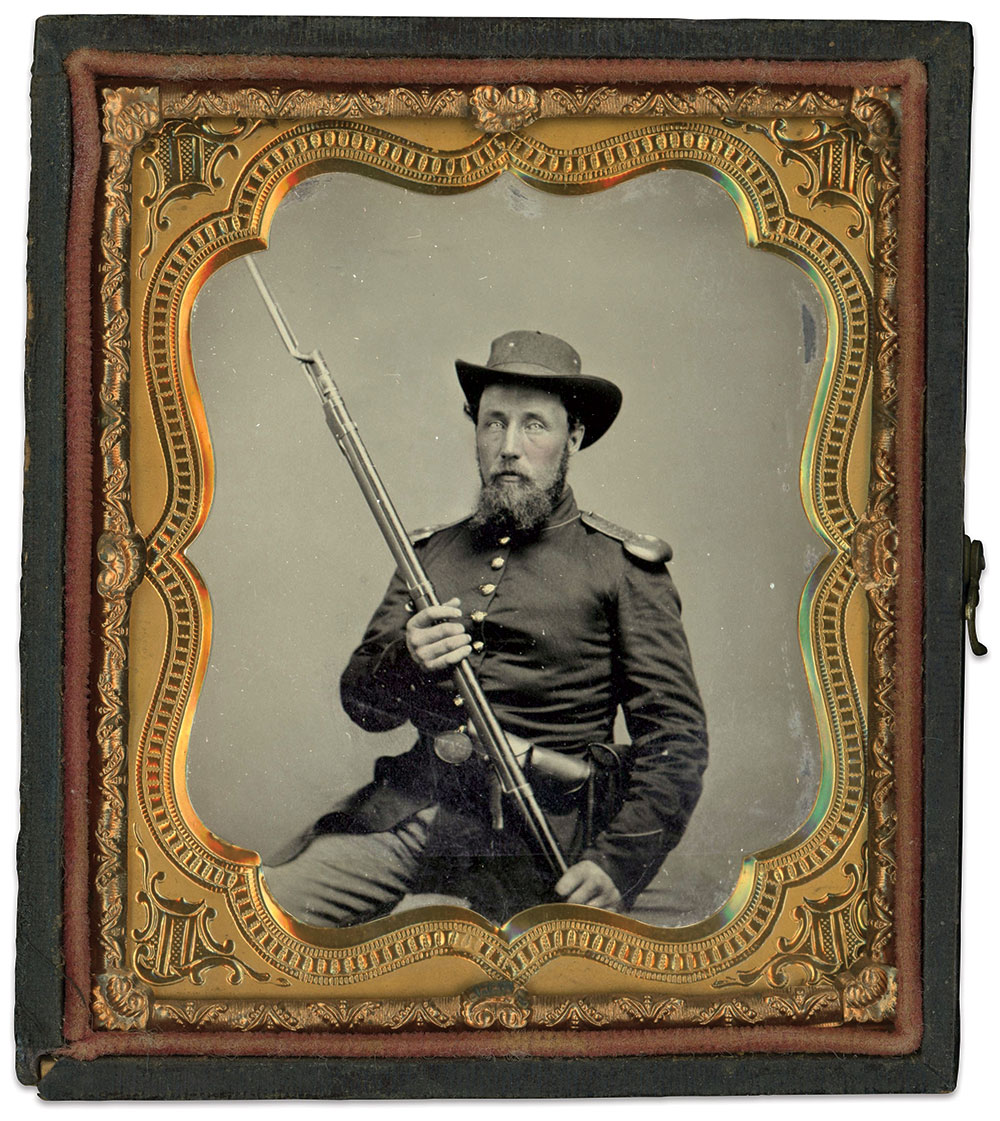
Sixth-plate tintype by an anonymous photographer.
David Flack numbered among Ohio’s first responders after the bombardment of Fort Sumter. On April 16, 1861, the 25-year-old enlisted in the 4th Ohio Infantry for a three-month term, and then reenlisted for three years when it became clear the war would last longer than anticipated. The regiment spent the majority of its service with the Army of the Potomac and participated in most of its major engagements. Flack survived them all, and mustered out in 1864. He lived until 1906.
In this early war view, Flack holds a U.S. Model 1822 musket, also known as the U.S. Model 1816 Type II .69-caliber. It has been converted from flint to percussion by the cone in barrel, also known as the Belgian alteration method. Also visible is a standard OVM waist belt plate, cartridge box (worn on the waist belt rather than being suspended from a shoulder belt), cap pouch and revolver holster. Of specific interest is his hat, which appears to have vent holes to prevent overheating.

Ninth-plate ambrotype by an anonymous photographer.
Chaplain Charles Babbidge of the 6th Massachusetts Infantry made the infamous march through Baltimore on April 19, 1861, when pro-secession mobs attacked.
Babbidge, an 1828 Harvard graduate and a Unitarian minister, recalled that the mobs targeted the flag as they made their way through the city. Soon after he and his comrades arrived in Washington, D.C., their colonel became concerned for the safety of the flag, and asked Babbidge to keep it safe. According to the history of the 6th, “The chaplain folded it carefully, and buttoned it across his breast, beneath his coat, saying occasionally to himself, ‘I hope, if I’m hit, it will be in the breast, and that old flag will stop the ball.’” The opportunity did not arise before the regiment’s three-month enlistment ended.
Commissioned chaplain of the 6th in 1857, Babbidge is seen here in the regiment’s gray militia uniform, complete with an Edmands hat, a unique issue to selected Massachusetts units early in the war. He appears to be asleep or in prayer.
The veteran clergyman went on to serve a three-year stint in the 26th Massachusetts Infantry. He lived until age 91, dying in 1898.
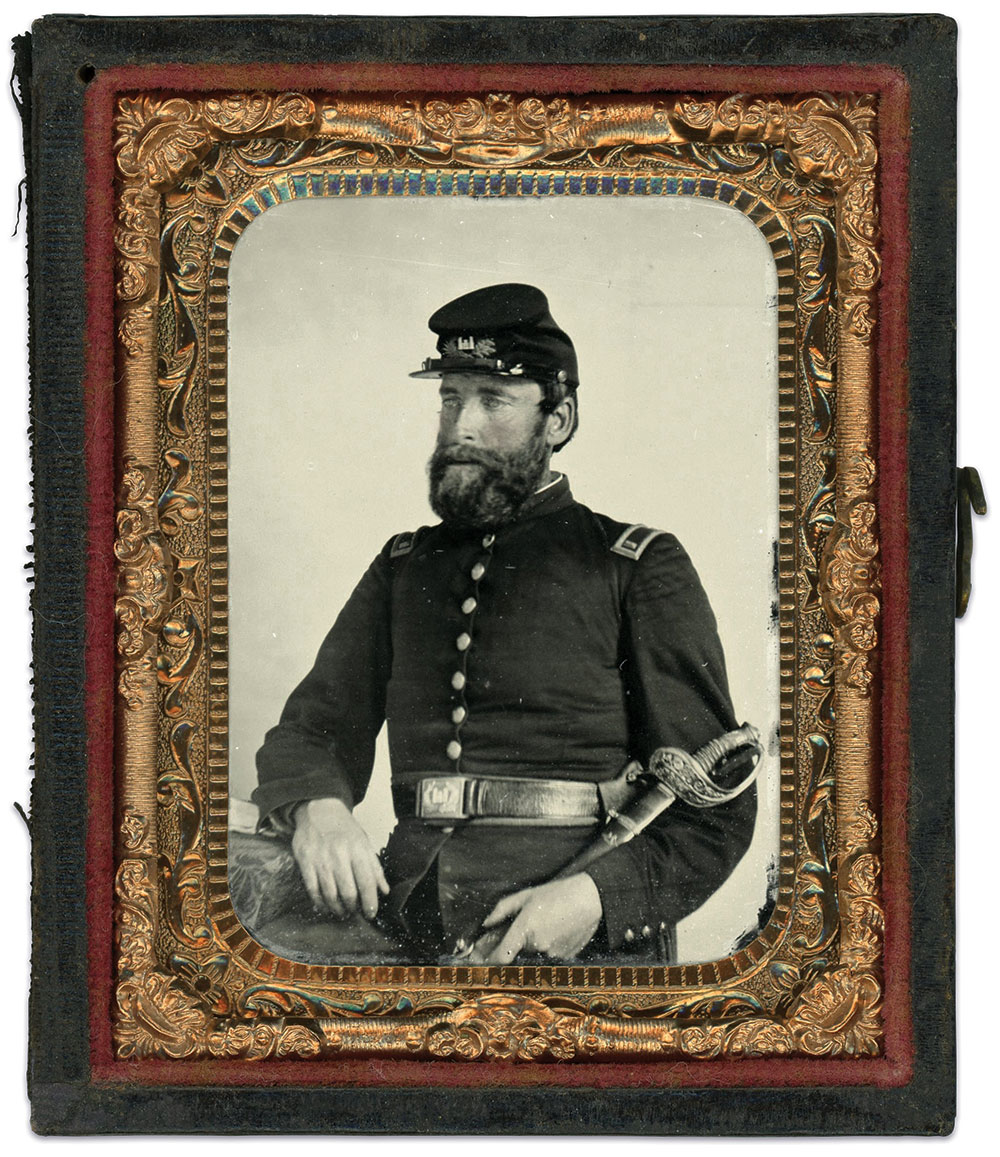
Ninth-plate ambrotype by an anonymous photographer.
This thick-bearded federal first lieutenant served in the engineers, as evidenced by the prominent fortifications insignia on his cap and waist belt plate, and the distinctive low convex Essayons, or engineer, buttons on his uniform. He cradles a U.S. Model 1850 Staff & Field sword in his lap.

Sixth-plate ambrotype by an anonymous photographer.
This freckle-faced young man, left, is likely a son of Massachusetts, as evidenced by what appears to be a 3-piece button design embossed with the crest of the Bay State. Looped around one finger is a piece of jewelry, perhaps a watch chain and fob, or a lucky charm. If a talisman, its impact on his fate while in uniform is unknown.
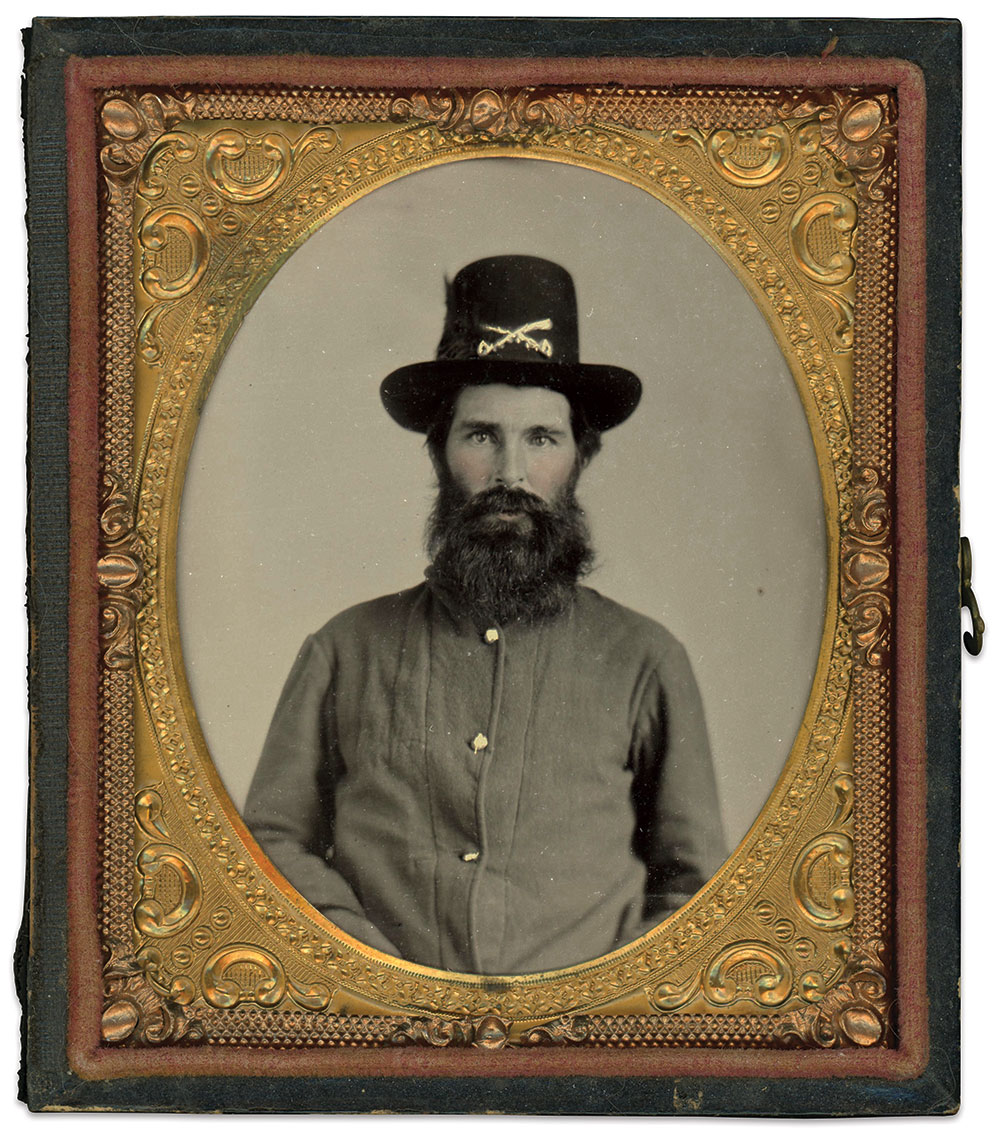
Sixth-plate tintype by an anonymous photographer.
This federal trooper modified his regulation Hardee hat by turning down the normally upright side opposite the black ostrich plume. This adjustment was common to Union soldiers in the Western Theater. He also wears a four-button sack coat common to late-war images.
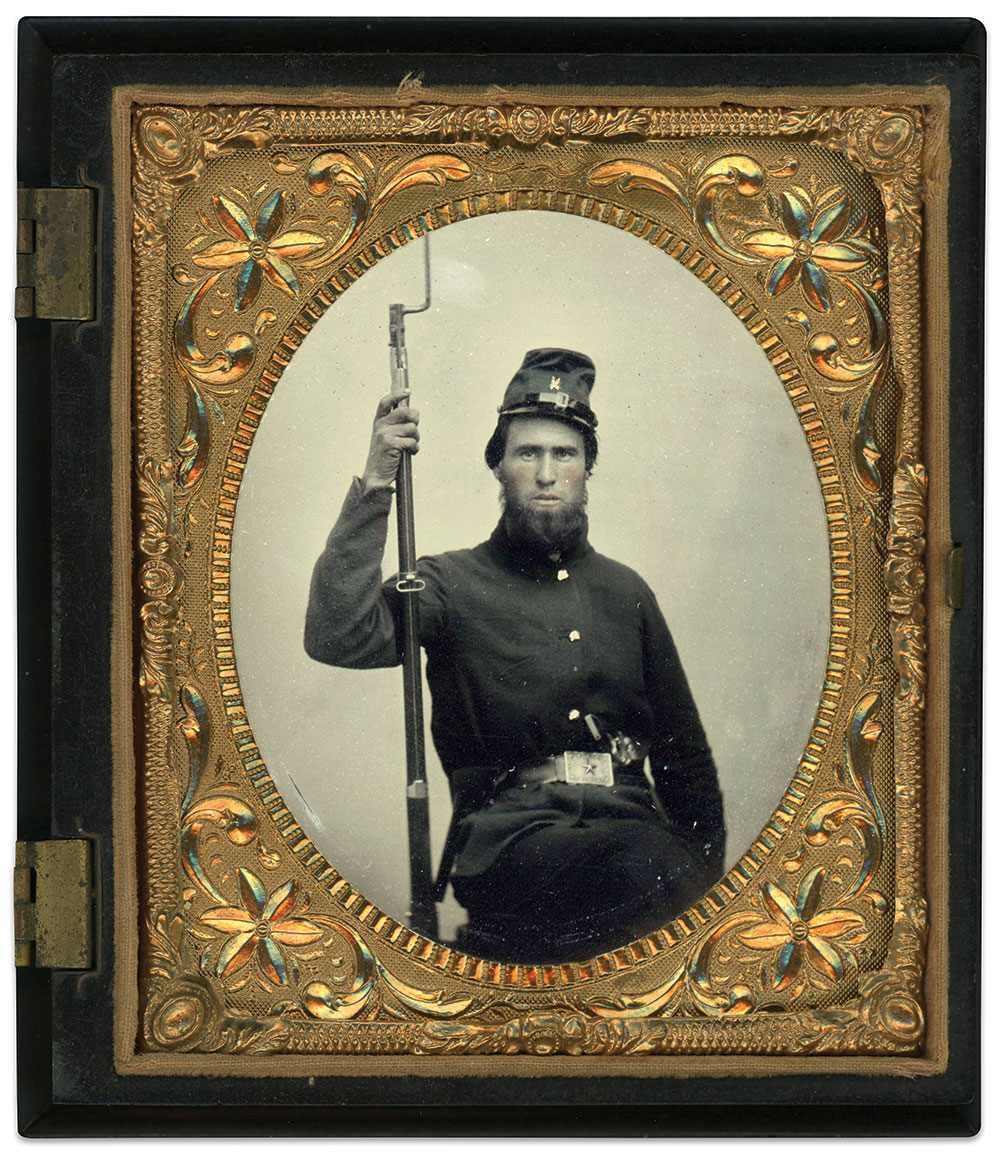
Students of Civil War plates will likely find the example worn by this infantryman of special interest. Known as a panel plate, this version is embellished with a five-pointed star and intricate floral border. Made of thin, die-stamped sheet brass with a tongue and belt loop soldered to the reverse, they were produced for general militia usage and popular with companies throughout the country in the 1840s and 1850s.
Also noteworthy is his sack coat. Close examination reveals the material is fuzzy or pilled, which suggests substandard fabric used by the supplier.
The soldier is armed with a U.S. Model 1842 .69-cal percussion musket and socket bayonet and a Colt revolver of the Model 1849 or 1851 Navy variety.

Sixth-plate ambrotype by an anonymous photographer.
On Thursday, May 26, 1859, this seaman posed for his portrait to remember a unique tour of duty. A note tucked in the back of this case includes the particulars of the event and identifies the sailor as John William David. (It may be his full name, or his first name and two middle names.) He served aboard the frigate Sabine, part of a naval squadron dispatched to South America in October 1858 to seek redress after the garrison of a Paraguayan fort shelled the U.S. gunboat Water Witch. The vessel was on a peaceful mission of exploration when fired upon, which resulted in the death of an American sailor.
The Sabine served as the squadron flagship and carried a commissioner who negotiated a formal apology and treaty with Paraguay. After completing the mission, the Sabine returned to America and arrived in New York Harbor on May 9, 1859, seven months after departing for the expedition. This portrait was made two weeks later.
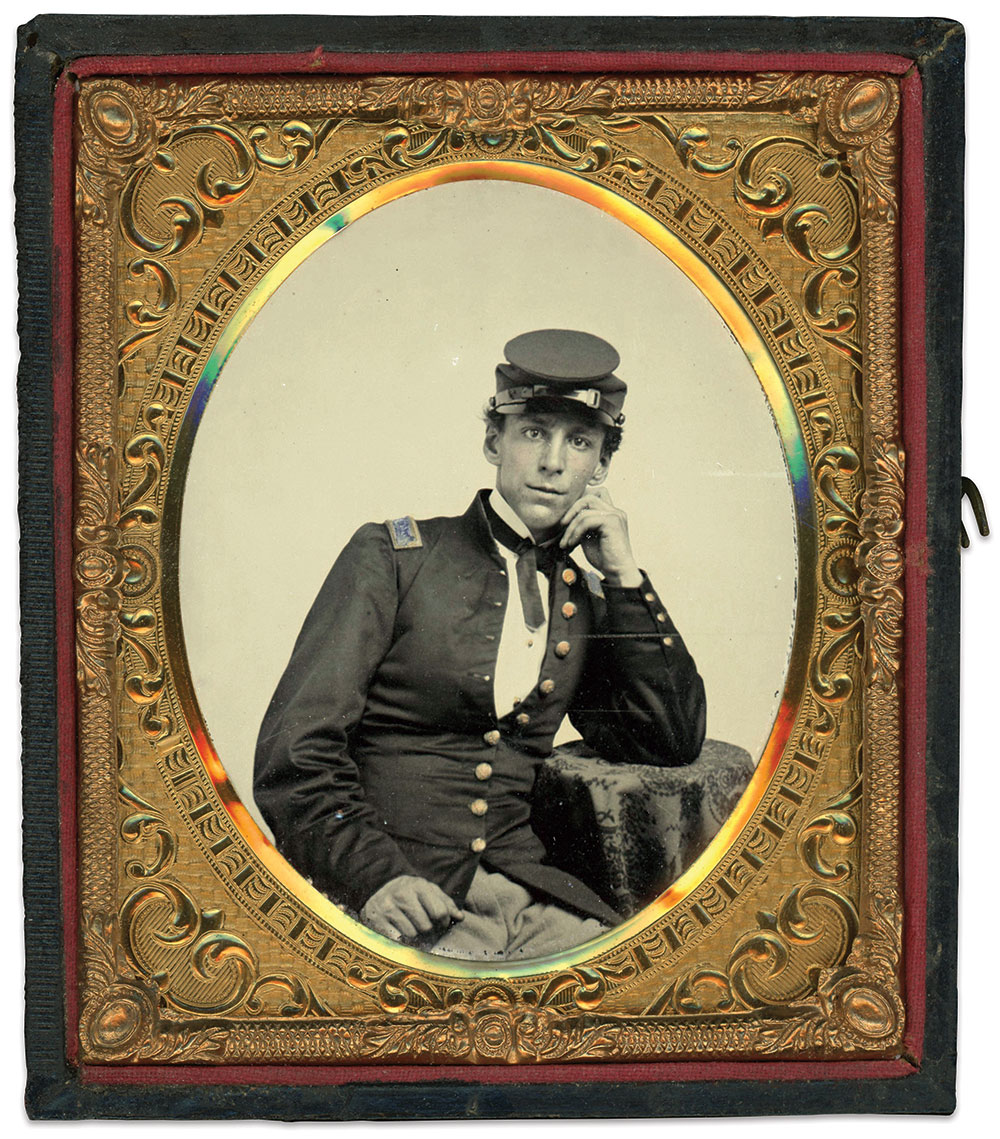
Sixth-plate ambrotype by an anonymous photographer.
This Union second lieutenant of infantry strikes a thoughtful pose, though it may be less a reflection of his personality and more the result of a simple need to hold his head still during the exposure time required by the photographer.

Sixth-plate ambrotype by an anonymous photographer.
Though the wheel hat is largely identified with Mexican War soldiers, it was worn by militia up to the Civil War, as evidenced by this portrait, circa 1858-1860. The brass cannon insignia attached to his Pattern 1839 cap specify his service as an artilleryman. The uniform jacket includes cloth shoulder tabs and a stand-up collar with silver lace trim and buttons of a 3-piece design. Note the horsefly on the shoulder of his jacket.

Ninth-plate ambrotype by an anonymous photographer.
If New York State had commissioned a photograph to document its distinctive shell jacket, they likely would not have achieved a better result than this portrait. The enlisted man, with a close-cropped Abe Lincoln-style beard, shows off his brand new uniform, complete with eight buttons, piped cloth shoulder tabs and Empire State buttons. A reinforced slit pocket provides a convenient place to store a handkerchief (as seen here), a pocket diary, papers or other small items.
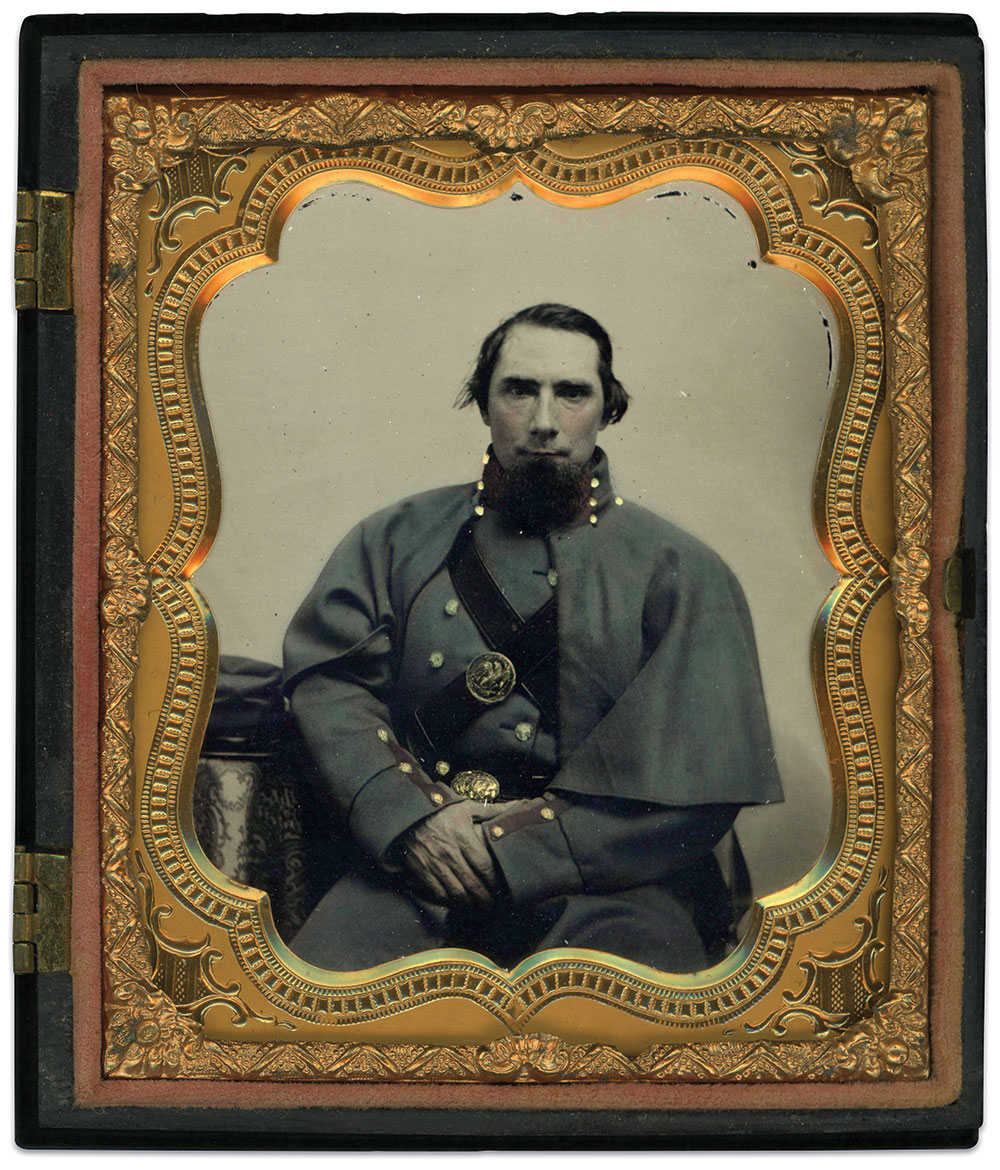
Sixth-plate ambrotype by an anonymous photographer.
The bushy beard worn by this infantryman obscures part of the collar of his greatcoat. But the whiskers cannot hide the crossed leather belts beneath his cape. Suspended from the belt with the Pattern 1826 plate was either a bayonet or a noncommissioned officer’s sword. A cartridge box hangs from the other belt. The other belt around his waist is fastened by a regulation Pattern 1839 oval plate.
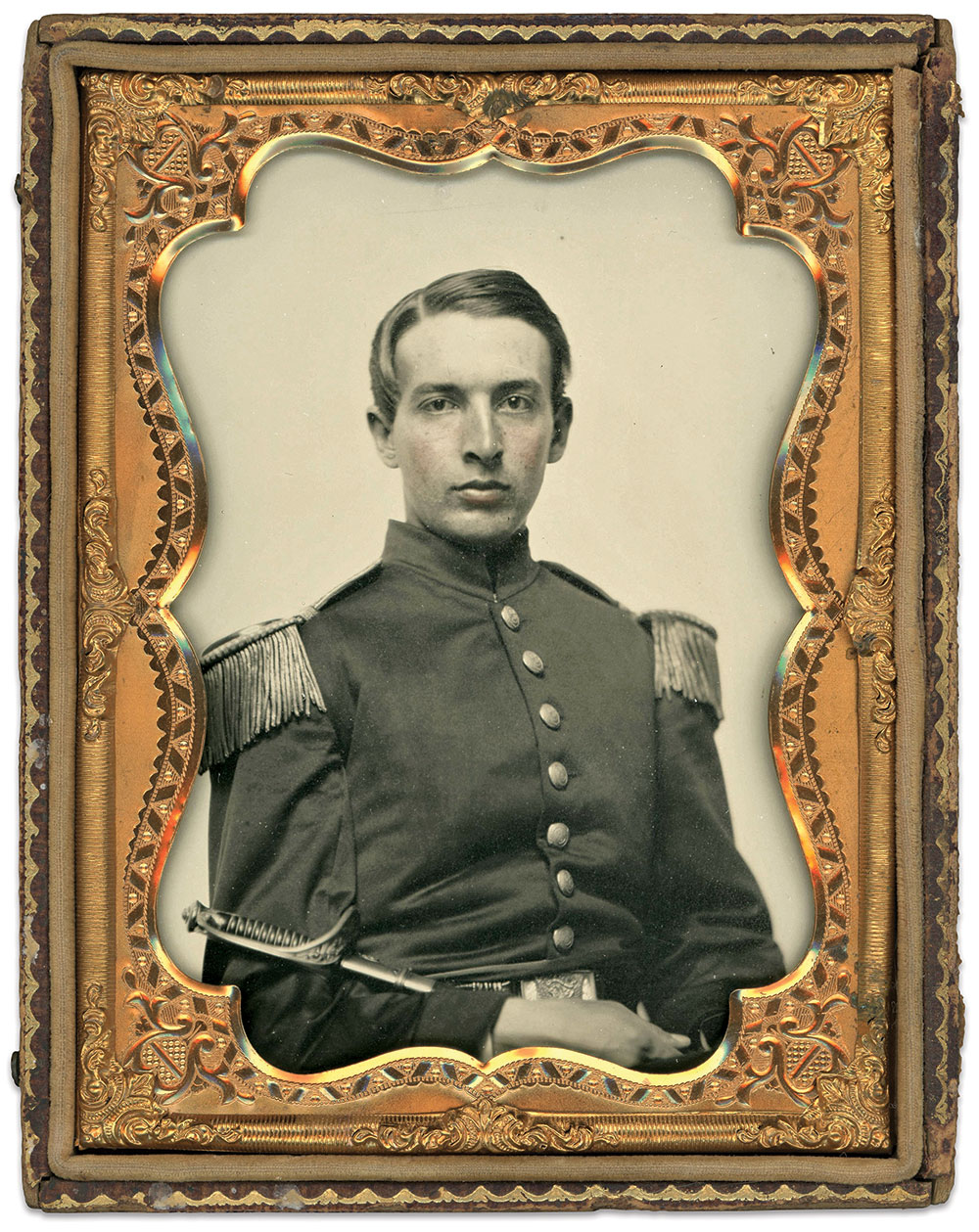
Quarter-plate ambrotype by an anonymous photographer.
“May 1861” is crudely scratched into the back of this portrait of a well-groomed infantry officer, whose Connecticut seal buttons denote his state of origin. By the end of May 1861, the state had organized three regiments of infantry and one of artillery, all for three-month terms of enlistment. This officer wears fringed epaulettes and a regulation Pattern 1851 waist belt plate. He holds a U.S. Model 1850 Foot Officer’s sword.

The crow’s feet around the eyes and deep age lines flanking the mouth of this chunky Union captain suggest he was born prior to the War of 1812. Dressed in a single-breasted frock coat with a high collar, he wears a McClellan style cap with piping. He appears to hold a well-used handkerchief in his hand.
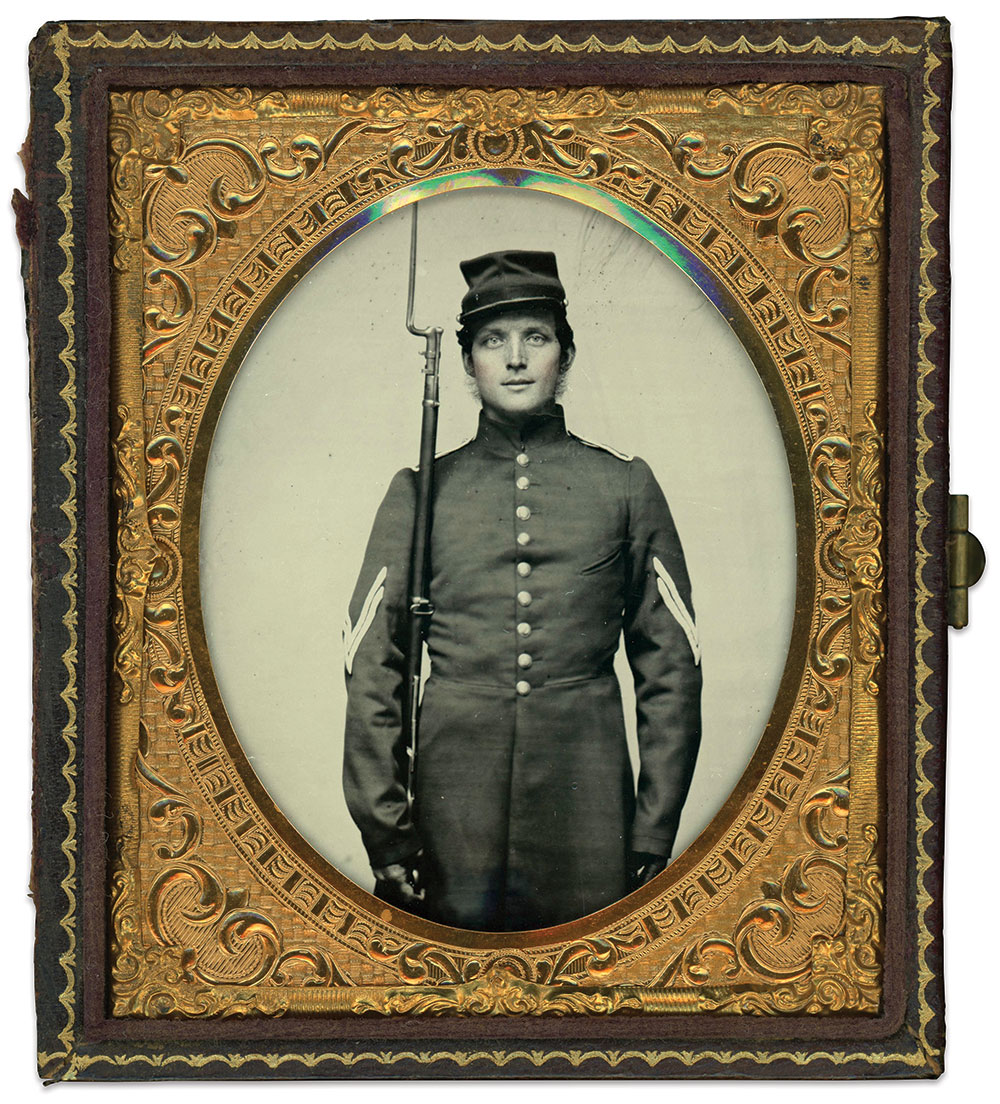
Sixth-plate ambrotype by an anonymous photographer.
A role model of the principle of shouldered arms, this corporal holds a Colt revolving rifle with socket bayonet affixed. His slightly upturned mouth suggests a smile. The nine-button frock coat with a slit pocket on the left breast and cloth shoulder tabs includes staff buttons that appear of the Massachusetts Volunteer Militia variety. Note that the image is not reversed, unlike most ambrotypes and tintypes of the period. This resulted from the photographer or someone else flipping the glass and turning the emulsion side away from the viewer.

Sixth-plate ambrotype by an anonymous photographer.
The cap purchased by this sergeant wearing a four-button sack coat indicates that he served in Company B of the 11th New Hampshire Infantry. Organized in the summer of 1862, the regiment participated in the Battle of Fredericksburg, the Vicksburg Campaign and the 1864 Overland Campaign engagements, including The Wilderness, Spotsylvania, Cold Harbor and the Crater.

Half-plate ambrotype by an anonymous photographer.
The mottled complexion of this older enlisted man may be explained by a variety of causes, including hereditary freckles, sun damage or a skin disease. His cap and coat indicate his service in the infantry.
SPREAD THE WORD: We encourage you to share this story on social media and elsewhere to educate and raise awareness. If you wish to use any image on this page for another purpose, please request permission.
LEARN MORE about Military Images, America’s only magazine dedicated to showcasing, interpreting and preserving Civil War portrait photography.
VISIT OUR STORE to subscribe, renew a subscription, and more.

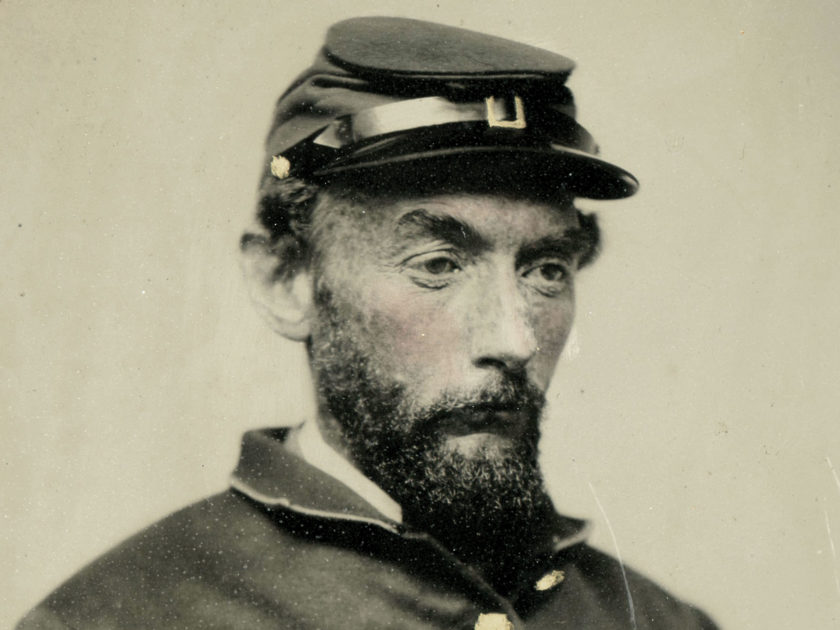
1 thought on “Crystal Clear: Representative portraits from the Dan Binder Collection”
Comments are closed.